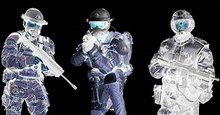Modern Camouflage Philosophy
RangerMade Science of Concealment
Camouflage
cam·ou·flage (kam-oe-fläzh, -fläj)
The method or result of concealing personnel or equipment from an enemy by making them appear to be part of the natural environment. To conceal or disguise, usually through misrepresentation or other artifice.
The definition of of camouflage as it pertains to modern warfare, refers to the ability to confuse through visual deception
an (Enemy) observers' ability to assess and accurately percieve and translate what he is viewing. It also refers to the material and/or action used to accomplish this.
RangerMade was founded on the principles of superior concealment techniques. Our sales have since been restricted to specially selected entities that we choose based on their ability to maintain and preserve the integrity of our products as a "sensitive item". Here is an excerpt from our piece about keeping pace with the changing need on the battlefield.
History:---conventional wisdom or practical ignorance?
The concept of personal concealment is evidenced in early American wars where Indians capitalized on their ability to conceal themselves. The British true to a form reminicent of Rome with their spit and polish flash, were run off the continent taking their silly red uniforms with them. Numerous precidents of failure such as these stem from a dangerously flawed psychology tragically ignorant of the merit and tactics of guerilla war. Uniform fabrics have changed through history from blue & grey to olive/khaki, traditional camo, and now ACU and MARPAT "digital". On the civilian front, the market finally exploded during the 90s with printed and photo patterns for hunting fanatics, but most of these fell short with inadequate fabrics and nearly always too dark colors that fail to provide realistic human signature reduction.
What do we know now?
There are several critical factors that provide visual deception:
Color, Pattern depth and size, Shading, and Fabric composition. These all work together to determine the effectiveness of design.
Modern Tech Solutions for:
Color:
Most artifiical colors and fabrics seem to darken with distance. Number of elements or colors: The obvious goal here is to match as closely as possible those in an immediate given environment. Typically an exact and constant match is unrealistic given textile material limitations without variable fiber-optic technology which is still largely unavailable for mass consumption. One solution currently employed by the US Military is to devise one or two all purpose schemes selected to fit over the broadest range of environments. It stands to reason then that this may not be the "absolute best" for a specific environment; however, computer color sampling can be done on digital photo series, taken on site if possible under various light conditions to determine what is best color fix for your specific needs.
Patterns & Depth: Again, the obvious answer here is a terrain specific pattern, but real world conditions with constantly changing variables and naturally occuring inconsistancies make this challenging without a self adjusting geo-morphable system. Depth is where we attempt to create a 3 dimensional effect. This is accomplished by shading, fabric types, and textures. We know that stark contrast is needed as patterns tend to blend together with distance. The human eye is (at best) only capable of discerning MOA (minute of angle) which is roughly 1":100m. exp. 3"@ 300m. etcetera. This means that an average anticipated viewing distance should be a consideration decided upon when formulating new concealment recipies. We call this Mean Anticipated Engagement Range (MAER). Experience has shown that broad horizontal stripe patterns help to create depth and break-up and confuse the easily recognizable human outline. Diminishing this outline can be further enhanced by oversizing the uniform so that it bunches and hides regular features typical to a human silouhette. Sizing is done to ensure that normal movement and articulation are improved not impaired. The result from this type of styling may differ from traditional asthetics at point blank range, but the objective is an unconventional mission specific guerilla camouflage solution, not a pretty military approved parade costume.
Fabric:
We know that many traditional fabrics do not absorb light the same as organic matter. This can cause natural light to be reflected and cause distorted viewing opportunities. We ameliorate for this by mixing natural and artificial fabrics, and deliberately manipulating an artificial fabrics' typical composition. Breathable fabrics are specially selected to absorb and diffuse light at differant rates mimicing nature to give the desired effect. This is further enhanced by adding "trim" or external streamers for dimensional outline dispruption.
Summary of Results
By identifying and solving for these factors that influence a humans' perception over what it sees, we can assemble a concealment product for maximum effect. Our end product can be a multi-purpose unit for general issue, or a special season & locale distinct product tailored for specific use. It factors MAER into a distance pattern, and can feature multi-dimensional depth, made more breathable and cooler by partial mesh construction. Colors and shading can be blended and digitally pixelated to achieve your tactical objectives.
If you are interested in learning more about RM Military tactical Camouflage Concepts and are a Special Operations Procurment Officer, or private security firm seeking unique designs for use away from a currently active theatre of operation, please call or email as shown on our contact page to schedule a viewing and demonstration.
Friday, September 15, 2006
Subscribe to:
Comments (Atom)
